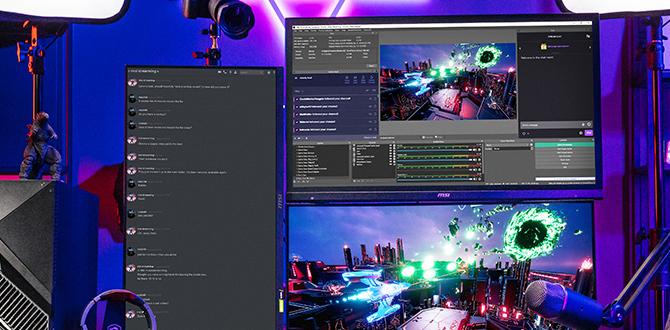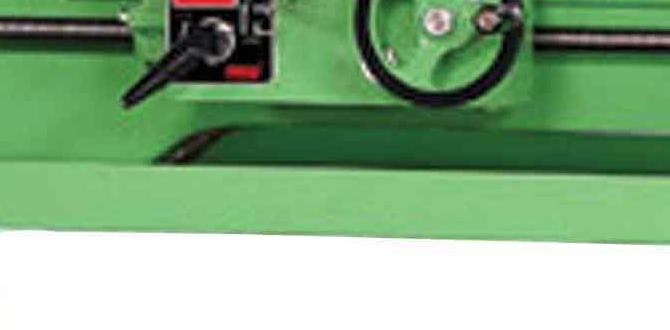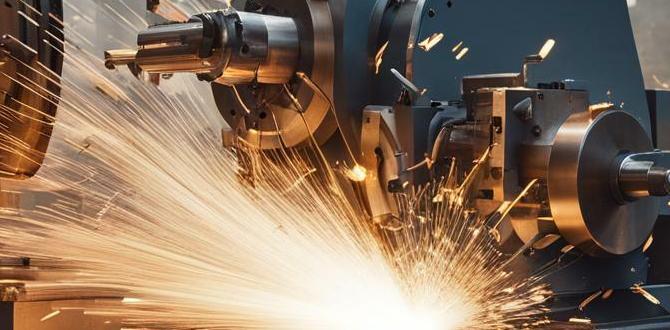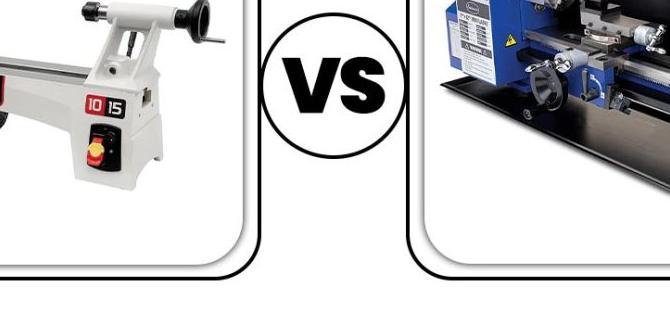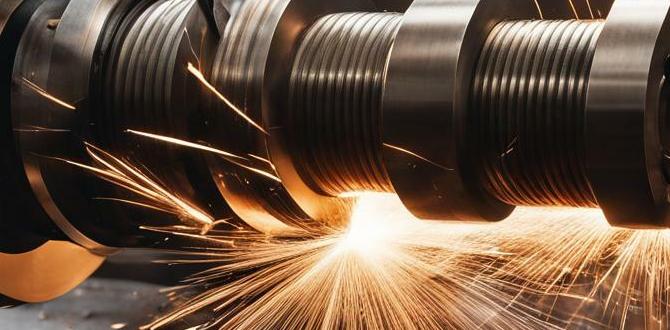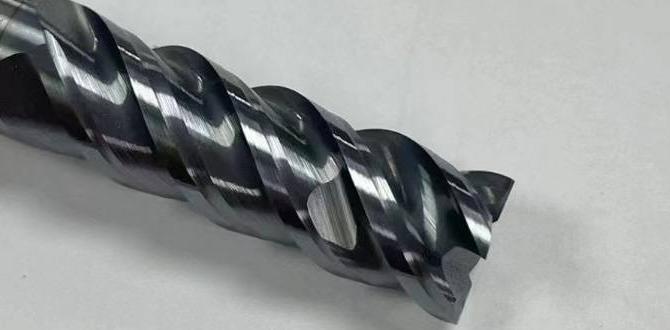Wood lathe torque control is essential for safer, more precise woodworking, preventing stalls during heavy cuts and ensuring smoother finishes. Mastering it allows for greater creative freedom and better results.
Taking on woodturning projects with your lathe can be incredibly rewarding. You can create beautiful bowls, spindles, and intricate designs. But sometimes, especially when you’re just starting out, you might run into a frustrating snag: your lathe stalls or bogs down when you try to take a heavier cut. It’s a common issue that can stop your project in its tracks and make you doubt your abilities. Don’t worry, this is where understanding wood lathe torque control comes in. Getting a handle on this will not only make your turning experience smoother but also much safer. We’ll break down exactly what torque is, why it matters for your wood lathe, and how you can effectively manage it to achieve fantastic results. Let’s dive in and learn how to keep your lathe running strong!
Understanding Wood Lathe Torque: What It Is and Why It’s Crucial
At its heart, torque is a twisting force. Think of it like the force you apply when you’re opening a stubborn jar lid – that rotational effort is torque. On a wood lathe, torque is the power that spins your workpiece. Without enough torque, the motor struggles, and the workpiece can slow down or stop entirely. This is especially true when you’re removing a lot of material quickly, like when turning a large blank or working with tough hardwoods.
Why Torque Matters for Your Wood Lathe Projects
Proper torque control is more than just about brute strength for your lathe; it directly impacts the quality and safety of your work.
Preventing Stalls: The most obvious benefit is avoiding those frustrating stalls. When the lathe’s motor can’t overcome the resistance from the wood, it stalls. This sudden stop can be dangerous, potentially causing tools to catch and splinter the wood, or even worse, kickback.
Achieving Smoother Finishes: Adequate torque allows for consistent cutting. When the lathe has enough power to maintain a steady speed, your tools glide more smoothly across the wood. This results in a cleaner surface finish, requiring less sanding later on.
Handling Different Woods and Techniques: Different wood species have varying densities. Hardwoods, for example, require more torque to turn than softwoods. Similarly, certain turning techniques, like roughing out a large bowl blank, demand higher torque than fine detail work. Being able to manage torque ensures your lathe can handle the demands of your chosen material and method.
Extending Tool and Motor Life: Constantly straining the motor by overloading it without sufficient torque can lead to premature wear and tear. Proper torque management ensures the motor operates within its optimal range, prolonging its lifespan.
The Difference Between Horsepower and Torque
It’s easy to confuse horsepower and torque, but they’re distinct. Horsepower is a measure of how quickly work can be done – it’s about the rate of doing work. Torque, on the other hand, is the twisting force itself. Think of it this way: a small engine with a lot of torque can get a heavy truck moving from a standstill, even if it can’t reach high speeds quickly (low horsepower). A sports car has high horsepower, allowing it to accelerate rapidly, but might not have the same initial pulling power off the line as the truck. For a wood lathe, both are important, but torque is what keeps the workpiece spinning consistently when facing resistance.
Types of Wood Lathe Drive Systems and Their Torque Characteristics
The way your wood lathe is powered directly influences its torque capabilities. Understanding these differences will help you appreciate why some lathes handle certain jobs better than others.
Belt Drive Lathes
Most beginner and intermediate wood lathes use a belt drive system. These lathes typically have a motor that turns at a high speed, and a system of pulleys and belts to transfer that power to the headstock spindle.
How it works: The motor’s speed is often changed by moving the belt to different-sized pulleys. A common setup is a 3-step pulley system:
Large Pulley: Offers high torque and lower speed – ideal for initial roughing and large blanks.
Medium Pulley: A balance of speed and torque.
Small Pulley: Offers lower torque and higher speed – good for fine detail work and sanding.
Torque Control: In a belt drive system, torque control is achieved by selecting the right pulley combination for the task. When you need more power to turn a dense piece of wood, you switch the belt to the largest pulley on the headstock and the smallest on the motor to maximize torque at a lower RPM.
Pros: Generally more affordable, simpler mechanism, good for a wide range of tasks when pulleys are used correctly.
Cons: Requires manual belt adjustments, which can be inconvenient, especially when changing tasks frequently. Can sometimes slip if severely overloaded or if belts are worn.
Direct Drive Lathes
More advanced and often larger lathes may feature a direct drive system. Here, the motor is directly connected to the headstock spindle, eliminating belts and pulleys.
How it works: The motor shaft is the spindle, or it’s directly coupled to it. Speed control is typically electronic, managed by a Variable Frequency Drive (VFD).
Torque Control: VFDs allow for precise electronic speed adjustment and can often provide variable torque across the speed range. This means you can adjust the RPM and the power with a dial or digital interface. Many VFD-controlled lathes are designed to maintain consistent torque even as the speed changes.
Pros: Smooth operation, instant speed changes, often more powerful and responsive, virtually no slippage.
Cons: Usually more expensive, initial setup/programming of VFD might be required.
Variable Speed Gearboxes
Some higher-end lathes use a gearbox system, similar to a car transmission, to offer a range of speeds and torque multiplication.
How it works: Gears are engaged to change speed and torque ratios.
Torque Control: Offers robust torque at lower speeds, controlled by shifting gears.
Pros: Very strong torque, durable.
Cons: Can be heavier, less common in smaller lathes, shifting can be more complex than a VFD dial.
Mastering Torque for Different Turning Tasks
The key to effective torque management is understanding how much power your lathe needs for specific operations. It’s all about matching the lathe’s capability to the demands of your workpiece and your cutting technique.
Roughing Out Large Blanks
When you start with a large, square, or irregularly shaped piece of wood, you’re asking a lot from your lathe. This is where you need maximum torque.
Pulley System: Select the largest pulley on the headstock and the smallest on the motor. This gears down the motor’s speed to provide the most twisting force.
Speed: Keep your RPM low – typically 400-600 RPM for larger blanks, depending on diameter and wood type. Lower RPMs are safer when dealing with unbalanced or green wood.
Cutting Technique: Use a broad scraping tool to break down the corners and round the blank. Make shallow passes. Allow the lathe to do the work without forcing the tool. If you hear the motor straining, you’re trying to remove too much material at once.
Turning Bowls
Bowl turning often involves significant material removal, especially in the initial stages.
Roughing: Similar to roughing out blanks, use lower speeds and maximum torque (largest pulley, smallest motor pulley). Focus on shaping the exterior first.
Hollowing: As you begin to hollow out the inside, you’ll still need good torque, but you might be able to increase the speed slightly if your blank is well-balanced. Listen to your lathe. If it groans, slow down or take lighter cuts. speeds between 600-900 RPM are common for roughing bowls.
Finishing: For final shaping and finishing passes on the interior and exterior, you’ll want to increase your RPM and can likely shift to a higher speed pulley. Speeds can range from 1000 RPM up to 2000+ RPM for finishing, depending on the bowl’s diameter and your comfort level. Lower speeds are generally safer for larger diameter bowls.
Spindle Turning (Legs, Bedposts, etc.)
Spindles are generally longer and thinner than bowls. They spin faster, and the demands on torque can vary depending on the diameter of the cut.
Roughing: For turning a square spindle round, you’ll still want decent torque. Start at a moderate speed (e.g., 600-1000 RPM) and take light passes.
Detailing: As you get into finer details, beads, and coves, you’ll typically want higher speeds to get clean cuts with chisels. You can shift to a faster pulley. Speeds can go up to 2000-3000 RPM or more for smaller spindles.
Torque Considerations: While high speed is desirable for detail, if you’re taking a substantial cut on a thicker part of the spindle, you might find the lathe bogs down. If this happens, slow down slightly or be more conservative with your cut depth.
Sanding and Polishing
These operations require high speeds for efficiency, but minimal torque.
Speed: Crank up the RPMs as high as your lathe safely allows for the diameter of your workpiece. For a 12-inch bowl, you might comfortably sand at 1500-2000 RPM. For smaller spindles, you can go much higher. Speeds for sanding can easily be 2000-3000 RPM or more.
Torque: Sanding and polishing remove very little material, so torque is not a major concern here. The focus is on achieving a smooth surface quickly.
Ensuring Safe and Effective Torque Management
Safety and effectiveness go hand-in-hand when managing torque on your wood lathe. Here are some proven practices:
Know Your Lathe’s Limits
Horsepower: Be aware of your lathe’s motor horsepower. Smaller lathes (e.g., 1/2 HP) are designed for smaller projects and lighter cuts. Trying to turn a large, dense hardwood log on a small lathe is a recipe for trouble. Larger lathes (1 HP and above) can handle more demanding tasks.
Weight and Stability: A heavier, more robust lathe will generally handle torque better and vibrate less than a lighter benchtop model.
Proper Material Selection and Preparation
Wood Type: Denser hardwoods (oak, maple, walnut) require more torque than softer woods (pine, basswood). Green wood is often easier to turn initially but can be less stable.
Blank Preparation: If you have a very irregular or unbalanced blank, consider roughing it into a more symmetrical octagon or hexagon shape before mounting it on the lathe. This reduces initial vibration and strain.
Smart Tooling and Cutting Techniques
Sharp Tools: Dull tools require more force to cut, which translates to a higher demand on torque. Keep your chisels and gouges razor-sharp. For a guide on sharpening, consider resources like the American Association of Woodturners (AAW) from the woodturner.org website.
Shallow Cuts: Especially when roughing or working with challenging materials, take light, controlled passes. Don’t try to remove too much wood at once. Let the tool and the lathe do the work gradually.
Correct Tool Presentation: Presenting your cutting tools at the correct angle relative to the workpiece is crucial. Incorrect angles can cause the tool to dig in, increasing the load on the motor.
Listen to Your Lathe
This might sound simple, but it’s one of the most effective ways to manage torque.
Motor Sound: A healthy motor running at its optimal torque will sound smooth. If the motor starts to labor, groan, or sound like it’s struggling, it’s a clear sign that you’re asking too much.
Vibration: Excessive vibration can indicate an unbalanced workpiece or that the lathe is struggling to maintain speed due to a lack of torque.
Consider a Variable Frequency Drive (VFD) Upgrade
For belt-drive lathes that lack sufficient power or direct electronic control, upgrading to a VFD system can be a game-changer.
How it Enhances Torque: A VFD allows you to electronically control the motor’s speed and can be configured to provide consistent torque across a wider RPM range. Some VFDs can even slightly boost torque at lower speeds or provide overload protection.
Benefits: Smoother speed changes, often more usable power, better control, and can make older lathes perform like new. Installation requires some electrical knowledge, so consult a professional or detailed guides if unsure. Resources like DIYGaga’s VFD installation guide can offer insights, though always prioritize your lathe’s specific manual.
Troubleshooting Common Torque-Related Issues
Even with best practices, you might encounter problems. Here’s how to tackle them.
Problem: Lathe Stalls or Bogs Down Constantly
Possible Causes:
Trying to take cuts that are too deep for the motor.
Wood is too dense or too large for the lathe’s horsepower.
Belt is slipping due to wear or improper tension.
Motor is overheating and losing power.
Tool is dull or poorly presented.
Solutions:
Reduce cut depth significantly.
Use lighter wood or smaller pieces.
Check belt condition and tension. Replace if worn.
Allow the motor to cool down. Ensure adequate ventilation.
Sharpen tools; check tool rest height and angle.
If using a belt drive, ensure you’re on the lowest speed/highest torque pulley setting.
Problem: Workpiece Vibrates Excessively Despite Slow Speed
Possible Causes:
Unbalanced workpiece (common with large squares or off-center mounting).
Lathe is not stable or is bolted down.
Tool is digging in, not cutting smoothly.
Solutions:
Rough out the blank to a more symmetrical shape before mounting.
Ensure the lathe is on a stable bench. Consider bolting it down.
Check tool sharpness and presentation. Ensure you’re making slicing cuts.
Problem: Lathe Seems Underpowered Even for Simple Tasks
Possible Causes:
Incorrect pulley selection for the task (too much speed, not enough torque).
Belt is worn out and slipping internally.
Motor is failing or has internal issues.
Electronics controlling the motor (on VFD lathes) are misconfigured or faulty.
Solutions:
Confirm you are using the lowest speed range / highest torque pulley for demanding tasks.
Inspect belts carefully. They can look fine but be internally glazed and lose grip. Replace if in doubt.
Have the motor checked by a qualified technician.
Consult your VFD manual or a technician for electronic issues.
Essential Wood Lathe Torque Management Table
Here’s a quick reference to help you choose the right setup for common woodturning tasks. Remember that these are general guidelines and actual needs will vary based on lathe power, wood type, and tool sharpness.
| Task | Typical RPM Range | Recommended Pulley Setup (Belt Drive) | Torque Requirement | Notes |
|---|---|---|---|---|
| Roughing Large Blanks (e.g., 10″+ diameter) | 300 – 600 RPM | Largest Headstock Pulley, Smallest Motor Pulley (Max Torque) | High | Use slow, steady cuts. Listen for motor strain. |
| Turning Bowls (Roughing/Shaping) | 400 – 800 RPM | Largest/Medium Headstock Pulley, Medium/Small Motor Pulley | Medium to High | Adjust based on bowl diameter. Be conservative with deep cuts. |
| Turning Bowls (Finishing/Detail) | 800 – 1500+ RPM | Medium/Small Headstock Pulley, Medium/Large Motor Pulley | Medium | Higher RPMs for smoother finishes. Larger bowls may need lower speeds even for finishing. |
| Spindle Turning (Roughing) | 600 – 1000 RPM | Medium Headstock Pulley, Medium Motor Pulley | Medium | Steady cuts to round the blank. |
| Spindle Turning (Detailing) | 1200 – 2500+ RPM | Small Headstock Pulley, Large Motor Pulley (Max Speed) | Low to Medium | Clean, crisp cuts. High RPMs help with fine details. |
| Sanding/Polishing | 1500 – 3000+ RPM | Small Headstock Pulley, Large Motor Pulley (Max Speed) | Low | Focus on speed for efficient material removal from sandpaper. |
Frequently Asked Questions About Wood Lathe Torque
- Q1: What is the most important factor for wood lathe torque control?
- A1: For belt-drive lathes, setting the correct pulley combination is paramount. For direct-drive

